Early Signs: Reports From a Warming Planet
Air Date: Week of March 17, 2006
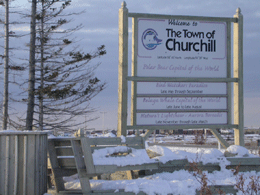
(Photo: Nick Miroff)
Living on Earth kicks off a six-part series of reports from places where climate change concerns are already bringing change. First stop: Churchill, Manitoba where Nick Miroff and Jon Mooalem report diminished polar ice is forcing a town to reexamine whether it has any future as "The Polar Bear Capital of the World."
Transcript
CURWOOD: It’s Living on Earth. I’m Steve Curwood. This week we begin a special series called "Early Signs: Reports from a Warming Planet." The series is a collaboration of the UC-Berkeley Graduate School of Journalism, Salon.com, and Living on Earth to document places around the world where people say they’re facing the impact of global warming. Places like the Arctic where it’s warming nearly twice as fast as the rest of the planet, according to a recent, eight-nation study.

As global warming threatens Churchill’s bear population, the town’s pitching bird watching in spring, whale watching in summer, and northern lights viewing in the dead of winter. (Photo: Nick Miroff)
KID: Oh, yeah! Ooooh, man, there’s ice. Woo-hoo! C’mon, let’s go.
[KIDS LAUGHING AND RUNNING]
MIROFF: The first snow came late to Churchill, Manitoba this year.
KID: Trick or Treat!
[KIDS TRICK OR TREATING; TRAFFIC SOUNDS]
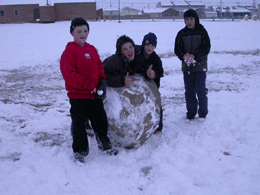
Young Churchillians playing with an ice ball outside Marlborough High School shortly after the season’s first snowfall. (Photo: Nick Miroff)
DYKE: It’s Halloween night and we’re just here handing out treats for the kids and making sure the bears don’t uh…come to town. Hey, guys!
MIROFF: A few hours earlier, a large male polar bear showed up in the town cemetery. So now, the Mounties are out with 12-gauge shotguns to keep the trick-or-treaters safe – from actual monsters.
DYKE: My name is Constable Sean Dyke and I’m with the Churchill Royal Canadian Mounted Police. We have these, uh, bear bangers.
[RATTLING SHELLS]
DYKE: It’s a little explosive charge that gets shot out of the shotgun (rattles) and just gives a huge bang.
[HALLOWEEN SOUNDS]
MIROFF: Churchill is a town of roughly 900 people, a shivering outpost on the otherwise vacant tundra south of the Arctic Circle. There are no roads in. Every fall, about a thousand polar bears lumber around just outside town waiting for Hudson Bay to freeze over. When it does, they’ll cross through Churchill and spend all winter on the ice, gorging on seals.
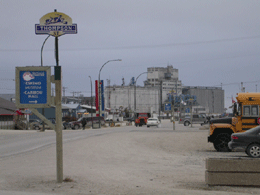
No roads lead to Churchill, Manitoba, a shivering outpost of roughly 900 people just south of the Arctic Circle. Kelsey Blvd. is the only paved street in town. It ends at the Port of Churchill. (Photo: Nick Miroff)
Visitors stay at the Lazy Bear Lodge, they eat at the Hungry Bear Café, and they buy bear mugs, bear key chains, bear sweatshirts, and bear baby bibs. For six weeks, the entire town runs on the rhythms of the tourists. Beat-up school buses take them out to the tundra every morning, and all the restaurants along Churchill’s strip fill up in unison at the end of the day. This routine’s been going on for over a decade. But this year, something’s off.
[HALLOWEEN SOUNDS]
DYKE: The ice is later in forming this year. You take a look at Hudson Bay here and it’s still open water.
MIROFF: So, the bears haven’t moved toward town in their usual numbers yet. Business owners are frustrated because the peak tourist season is almost over. Bear biologists are worried. There’s been a long-term warming trend here, so that freeze-up now comes about two or three weeks later than it used to. Churchillians, like the bears, have been waiting for any sign of winter.
ED: It’s snowing with big snowflakes which I don’t think it’s going to stay on the ground.
MARILYN: No, it’ll be gone by morning. If the wind picks up it’ll be surely gone. You want to grab some more candy, Ed?
[MUSIC]
MIROFF: Churchill has always depended on the bears in one way or another, and it hasn’t always worked out. When Danish explorers first landed here in 1619, they shot and ate them. But the meat was tainted with trichinosis, and nearly all the men died. It took another hundred years for British fur traders to figure out how to survive here, founding a tiny settlement out of a wilderness of belligerent quadrupeds.
[MUSIC ENDS]
PENWARDEN: Everybody in Churchill’s got a bear story. Everybody. (Laughs)
MIROFF: Bob Penwarden and his wife own The Tundra Inn, a small tourist hotel off Churchill’s main drag.
PENWARDEN: That’s a sonar Hageman, a Swedish military machine. It’ll go where you point it.
MIROFF: A slim, decommissioned rocket leans in the lobby behind a fichus, and there are NIKE missile adapters on the porch with plants in them. These are Bob’s keepsakes from the Cold War, a time when Churchill boomed as the U.S. and Canada built up a joint military base outside of town. Bob’s been here since 1962. He got a job launching communications and weather satellites.
PENWARDEN: The town never had a bear problem in those days. The military used lead poisoning; they just shot the bears. I don’t say they went out and hunted them. But if they came around and were a hazard, they took the line of least resistance and done away with them.
MIROFF: Churchill’s population swelled to 6,000 as government agencies and contractors flooded in.
PENWARDEN: Oh yeah, there were parties. They flew in lobster for New Year’s Eve. The military treated us pretty good. We had a real nice theater out there. We had a curling rink. As I say, it was good times. There were a lot of people, and it was a different world.
[HARP MUSIC]
MIROFF: The American military pulled out first. It caused a ripple effect.
PENWARDEN: When the big layoff came, what I refer to as “Black Thursday,” they assembled all of us and told probably a quarter of us that we were staying and the rest were going. So it was a pretty bad day. I had a crew of four people. And I used to say “let’s go gang,” and four of us would go out and work. And after Black Thursday, I had a crew of myself.
MIROFF: By the early eighties, Churchill was down to about 1,000 people. There were rows of empty buildings and an infrastructure the town couldn’t afford to keep up. Rocket shells were littered across the tundra and sunk in the Bay.
[MUSIC ENDS]
DEMEULLES: The soldiers left a lot of little ones behind. Well, it’s the truth. In the long run it was good that they left, because let’s face it, they couldn’t stay here forever. To begin with, I don’t even know what the hell they were doing here! Nobody ever told us anything, so…
MIROFF: Myrtle Demeulles runs a cultural center for people of mixed Inuit and European descent known as the Meti. She’s been in Churchill since 1955, coming at age 14 to find a husband. When the military left, she says, everyone scrambled to pick up the pieces.
DEMEULLES: They had an ambulance service, right? When they left, they gave it to the town. So, because I was already, I had a cab business, I was driving cab anyway, I decided to run the ambulance service, too, for five years. Until someone else took over, thank God.
MIROFF: Mike Spence was a teenager then.
[MUSIC]
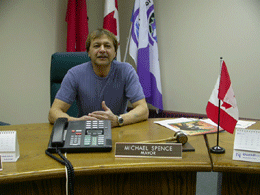
Mayor Mike Spence grew up in Churchill in its military heyday when it was a town of 6,000 people. (Photo: Nick Miroff)
[MUSIC]
SPENCE: There was a local person by the name of Len Smith, who was a mechanic by trade. And he put together just a small buggy. And he went east, east of here. At about that time, there was an American photographer who had had an opportunity to see some bears. Well, they hooked up, and basically, he told Len, he said “Len, you build the buggy and I’ll bring the tourists.”
[MUSIC ENDS]
MIROFF: Mike now runs two hotels, a restaurant, a flooring business, and the town’s only car rental agency. He’s also the mayor. Sitting in the town counsel chambers in a ribbed t-shirt and camouflage hunting jacket, he perks up a little whenever he uses the phrase, “Polar Bear Capital of the World.”
SPENCE: I grew up in a community of 6,000 people. So I’m still inspired to see a population of 6,000 people. That’s what inspires me.
[MOTOR NOISE, CAMERA SHUTTERS]
TOUR GUIDE: Sometimes it’s just about taking a quick shot, putting the camera down and enjoying the moment. Beautiful, beautiful. Be able to see a bear walk on the ice along there. Beautiful.
[TOURISTS CHATTERING, LAUGHING EXCITEDLY]
[MUSIC]
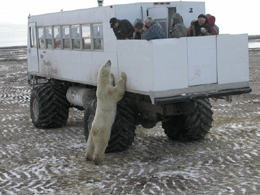
Tundra Buggies cart tourists over the tundra to overse the bears as they bide their time waiting to get back on the ice. Sometimes the bears observe them, too. (Photo: Nick Miroff)
TOURIST: One picked a pile of mud to lay down on. One is on straw.
[CAMERA SHUTTERS, CHATTER]
MIROFF: The rocket range in the distance, where Bob Penwarden once worked, is now a research center. A non-profit called Polar Bears International has been bringing scientists from all over North America to educate school and tour groups. Questions about global warming inevitably come up.
[SOUND OF CONVERSATION]
MIROFF: Dr. Jane Waterman is spending the afternoon on a tundra buggy monitoring bear behavior with a group of volunteers.
WATERMAN: The bears’ males will move onto land when the ice melts in July and, basically, go splat. Remember, these guys are on holiday right now. There’s no food, there’s no sex, there’s nothing. And it’s when the sea ice forms that they can get back out there and make a living.
[MUSIC]
MIROFF: A living for a male polar bear goes like this: stalking across the frozen Bay for six months, ambushing seal pups and yanking them through the ice. All they eat is the fat. A large male bear can eat 150 pounds of it on a good day.
[VOLUNTEER CHATTER]
MIROFF: The bears stay on the ice until the last of it melts on the part of Hudson Bay south of Churchill. There, they decamp. They spend all summer living off reserves in what’s called “waking hibernation,” waiting for freeze up. But, in fall, when the ice begins to form again, it forms first on the opposite side of Churchill—so the town is in their way.
[MOTOR NOISE]
WATERMAN: Most of them go through town because it’s their major migration zone, and they’ve been doing that for thousands of years, way before the town was there. Within 24 hours of the sea ice actually forming, these bears are gone.
MIROFF: Warmer temperatures mean the Bay is frozen for a shorter stretch each year--lengthening the time when the bears are forced onto land and not eating. As the ice disappears, researchers in Alaska report polar bears drowning, forced to swim between increasingly distant ice floes. Also, with less time on the ice to hunt, more bears are seen scavenging the beaches for whale carcasses.
WATERMAN: Certainly this is one of the warmest years I’ve ever seen. Usually in November we’re starting to see freeze up, and these fresh water ponds are still open water in them. And I don’t know if I’ve ever seen it like that at this time.
MIROFF: Churchill’s bear population has already fallen more than 20 percent in the past 17 years, and U.S. and Canadian researchers found this directly correlates to the loss of sea ice. The short-term predictions are dire.
GUNTER: My name’s Merv Gunter. My wife Linda and I own and operate the Tundra Buggy Adventure, the polar bear experience up in Churchill, Manitoba, and it’s probably the most fun job of anybody in the whole world.
MIROFF: Merv used to be a banker in Winnipeg. He may have more invested in Churchill’s bears than anyone.
GUNTER: Are we worried? Yes, I’m afraid so. And I think we should do everything we can about it. And can we do anything more than that to stop climate change? No. So we will co-exist with that. We’ll have to. As will the bears. They’re a very tenacious and a very amazing species with their ability to evolve and to adapt.
MIROFF: Some folks in Churchill seem convinced that the bears will find a way to survive. That they’ll learn to eat berries and evolve into grizzlies. The town has always gotten by on its pioneering spirit, especially after the military left. It may be they expect the same stubborn resilience out of their bears. But for the bears, it isn’t a question of will.
WATERMAN: Natural selection can happen very quickly in, like, bacteria, because they can breed in 20 minutes. Polar bears live 20 or 25 years. That means that for changes to occur genetically, it’s going to take a little bit of time. And that’s something they don’t have. So, no, if the change is as rapid as all the climate models predict, by the middle of this century, there’s no sea ice in Hudson Bay, there are no bears. If there’s no sea ice, you can’t have bears.
MIROFF: The irony of all of this is that, as the ice vanishes, taking the bears with it, global warming is clearing the way, literally, for a whole other industry.
[MUSIC]
MIROFF: Churchill happens to have Canada’s only Arctic seaport. It’s a summer port where ships load up on grain from the Canadian prairies. But that season is extending now, too. And with less ice, new trade routes are opening up through the Arctic to Russia.
But really, few people in town see this as a savior. Drumming up business for the port is up to the American company that owns it, and the Canadian Wheat Board down south. Instead, in Churchill, a frontier town where people are used to doing for themselves, there’s a curious streak of wishful entrepreneurialism about almost everything else.
Bob Penwarden bought the dilapidated radar station where he used to work and has talked about turning it into a convention center. One town planner wants to set up a call center in Churchill, or to manufacture pre-fab housing, even if it means having to haul it over the ice to Inuit communities further North. And even though Churchill’s difficult and expensive to get to, the town’s pitching bird watching in spring, whale watching in summer, and Northern Lights viewing in the dead of winter--when it’s 40 below.
SPENCE: We’re trying to build momentum with what we have, and naturally what we have, and again, I’ll refer to it as the “Polar Bear Capital of the World.” That is a selling point and that’s what we need to use. We need to build on it, we need to capitalize on it, and if we don’t, then we’re gonna slide and we can’t afford to slide.
DEMEULLES: We love this place. We learn to live with what’s happening—except for this warm weather! We just don’t understand what the heck’s going on. And really believe it’s the big cities down south causing it.
SPENCE: You know, the earth is warming, and so there are some dangers in climate change, as well. The bears, for instance, and how will they survive in a community that’s the Polar Bear Capital of the World.
DEMEULLES: I want to see what happens, if I have that many years left. I’ve got a mouth. And I’m a motor mouth. And if need be, I’ll speak up for the bears.
PENWARDEN: I’m worried. Because it’s the livelihood of a lot of people in this town. But I, I, I believe home is here for those bears. I don’t say these scientists are right. But I don’t even believe they’re right on this global warming. The bears, this is home. I, I, you know, I may be dead wrong. And, and, they do wander, and hell knows where they go? But they’ll be back, next spring.
[MUSIC]
CURWOOD: Our story about the polar bears of Churchill, Manitoba, was produced by Jon Mooallem and Nick Miroff. Next week, we travel to East Africa, to Lake Tanganyika. Water temperature in the world’s second deepest lake is rising, and some fear that could upset the balance of the nation's staple food, the sardine known as dagaa.
MAN: Oh it was so good. When we used to fish with our fathers, it was very good. There were so many dagaa. People could fish 5,000 tons. In tons! Back in those days there was so much dagaa.
CURWOOD: “Early Signs” is a collaboration of the UC-Berkeley Graduate School of Journalism, Salon dot com, and Living on Earth. To read a print version of this story and see photos of the polar bears of Churchill, visit our website Living on Earth dot org. That’s Living on Earth dot org.
 |
 |  |  |
Links
To see a print version of this story & more photos of the polar bears of Churchill, click here
Living on Earth wants to hear from you!
Living on Earth
62 Calef Highway, Suite 212
Lee, NH 03861
Telephone: 617-287-4121
E-mail: comments@loe.org
Newsletter [Click here]
Donate to Living on Earth!
Living on Earth is an independent media program and relies entirely on contributions from listeners and institutions supporting public service. Please donate now to preserve an independent environmental voice.
NewsletterLiving on Earth offers a weekly delivery of the show's rundown to your mailbox. Sign up for our newsletter today!
 Sailors For The Sea: Be the change you want to sea.
Sailors For The Sea: Be the change you want to sea.
 The Grantham Foundation for the Protection of the Environment: Committed to protecting and improving the health of the global environment.
The Grantham Foundation for the Protection of the Environment: Committed to protecting and improving the health of the global environment.
 Contribute to Living on Earth and receive, as our gift to you, an archival print of one of Mark Seth Lender's extraordinary wildlife photographs. Follow the link to see Mark's current collection of photographs.
Contribute to Living on Earth and receive, as our gift to you, an archival print of one of Mark Seth Lender's extraordinary wildlife photographs. Follow the link to see Mark's current collection of photographs.
 Buy a signed copy of Mark Seth Lender's book Smeagull the Seagull & support Living on Earth
Buy a signed copy of Mark Seth Lender's book Smeagull the Seagull & support Living on Earth

